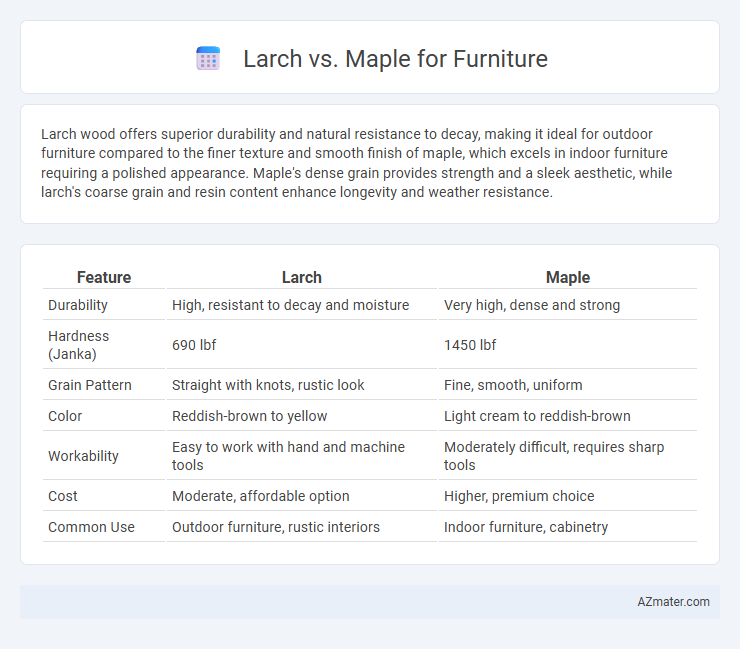Larch wood offers superior durability and natural resistance to decay, making it ideal for outdoor furniture compared to the finer texture and smooth finish of maple, which excels in indoor furniture requiring a polished appearance. Maple's dense grain provides strength and a sleek aesthetic, while larch's coarse grain and resin content enhance longevity and weather resistance.
Table of Comparison
| Feature | Larch | Maple |
|---|---|---|
| Durability | High, resistant to decay and moisture | Very high, dense and strong |
| Hardness (Janka) | 690 lbf | 1450 lbf |
| Grain Pattern | Straight with knots, rustic look | Fine, smooth, uniform |
| Color | Reddish-brown to yellow | Light cream to reddish-brown |
| Workability | Easy to work with hand and machine tools | Moderately difficult, requires sharp tools |
| Cost | Moderate, affordable option | Higher, premium choice |
| Common Use | Outdoor furniture, rustic interiors | Indoor furniture, cabinetry |
Introduction to Larch and Maple Wood
Larch wood, known for its durability and natural water resistance, is prized in furniture making for its rich reddish-brown tones and prominent grain patterns that enhance rustic and contemporary designs. Maple wood offers a hard, dense texture with a fine, consistent grain, making it ideal for smooth finishes and detailed woodworking in furniture construction. Both woods provide unique aesthetic and structural qualities, with larch valued for outdoor resilience and maple favored for indoor furniture and cabinetry.
Botanical and Structural Differences
Larch wood, derived from Larix species, features a dense, resinous grain with natural water resistance, making it ideal for durable, outdoor furniture. Maple, from Acer species, is known for its fine, uniform texture and hardness, offering a smooth finish suitable for indoor cabinetry and elegant furniture. Structurally, larch has a coarser grain and higher sapwood content, while maple provides consistent strength with minimal knots, enhancing its stability and aesthetic appeal.
Appearance: Color, Grain, and Texture
Larch wood features a warm, reddish-brown hue with pronounced, straight grain patterns and a coarse texture, giving furniture a rustic and robust appearance. Maple displays a lighter, creamy to pale golden color with fine, consistent grain patterns and a smooth texture, resulting in a sleek and refined look for furniture pieces. The contrasting colors and grain textures make larch ideal for bold, natural designs, while maple suits modern, polished aesthetics.
Durability and Strength Comparison
Larch wood exhibits exceptional durability and strength due to its high resin content, making it highly resistant to rot, decay, and insect attacks, ideal for both indoor and outdoor furniture. Maple is known for its dense, hard grain structure, offering superior strength and durability suitable for heavy-use furniture like tables and chairs. While maple typically provides a smoother finish and greater hardness, larch delivers enhanced weather resistance, making the choice dependent on the furniture's exposure and functional requirements.
Workability: Machining and Finishing
Larch wood offers moderate workability with a coarse texture that allows for smooth machining but can dull tools faster due to its resin content. Maple is highly favored for furniture-making because of its fine, even grain, which enables precise machining and excellent finishes that enhance its natural hardness and durability. Both woods accept stains and finishes well, but maple typically provides a more uniform surface for achieving a high-quality, polished look.
Resistance to Decay and Pests
Larch wood offers superior resistance to decay and pests compared to maple, making it an excellent choice for outdoor furniture and environments with high moisture exposure. Maple, while durable and hard, is more susceptible to insect damage and fungal decay, requiring more maintenance or protective treatments. For long-lasting furniture intended for variable conditions, larch's natural durability and resin content provide enhanced protection against biological threats.
Common Furniture Applications
Larch wood is valued in furniture making for its exceptional durability and natural resistance to moisture, making it ideal for outdoor furniture such as garden benches and patio sets. Maple offers a fine, uniform grain and hardness, which suits indoor furniture applications including dining tables, chairs, and cabinetry that benefit from a smooth finish and high wear resistance. Both woods provide distinct aesthetic qualities, with larch's warm, reddish hues complementing rustic designs, while maple's light, creamy tones fit well in contemporary and traditional interiors.
Environmental Impact and Sustainability
Larch wood offers superior sustainability due to its rapid growth rate and natural resistance to decay, reducing the need for chemical treatments in furniture production. Maple, while denser and more durable, grows more slowly, impacting its renewability and carbon sequestration potential. Choosing larch for furniture supports eco-friendly practices with lower environmental footprints compared to maple's resource-intensive harvesting.
Cost and Availability Analysis
Larch wood typically offers a more affordable option compared to maple, making it suitable for cost-conscious furniture projects while still providing durability and a distinct grain pattern. Maple, often priced higher due to its hardness and fine, uniform texture, is widely preferred for high-end furniture and woodworking applications. Availability of larch can be region-dependent, commonly found in northern hemisphere forests, whereas maple is generally more accessible in North America and Europe, ensuring better market supply and consistent pricing.
Choosing the Right Wood for Your Furniture Project
Larch wood offers high durability and natural resistance to moisture, making it ideal for outdoor furniture projects that require weather resistance. Maple, known for its fine, smooth grain and hardness, is preferred for indoor furniture demanding a polished and elegant finish. Selecting the right wood depends on the furniture's intended use, with larch excelling in robustness and maple providing superior aesthetic quality and wear resistance.

Infographic: Larch vs Maple for Furniture
 azmater.com
azmater.com